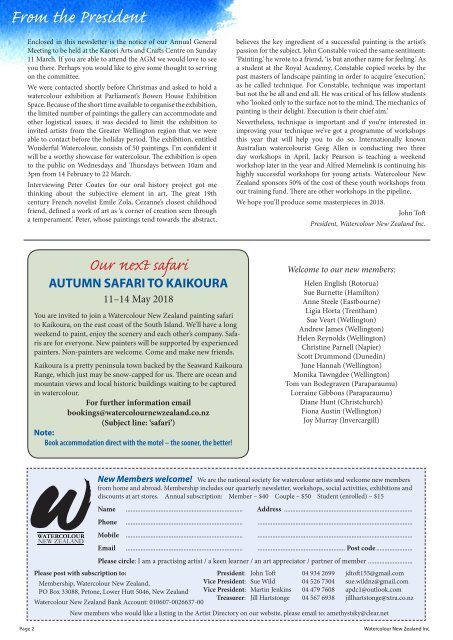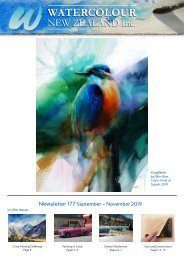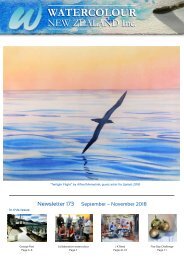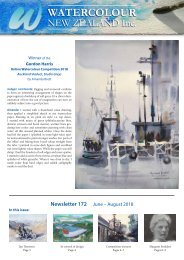Watercolour New Zealand Newsletter #171
Watercolour New Zealand Newsletter #171 March - May 2018 http://www.watercolournewzealand.nz
Watercolour New Zealand Newsletter #171 March - May 2018 http://www.watercolournewzealand.nz
You also want an ePaper? Increase the reach of your titles
YUMPU automatically turns print PDFs into web optimized ePapers that Google loves.
From the President<br />
Enclosed in this newsletter is the notice of our Annual General<br />
Meeting to be held at the Karori Arts and Crafts Centre on Sunday<br />
11 March. If you are able to attend the AGM we would love to see<br />
you there. Perhaps you would like to give some thought to serving<br />
on the committee.<br />
We were contacted shortly before Christmas and asked to hold a<br />
watercolour exhibition at Parliament’s Bowen House Exhibition<br />
Space. Because of the short time available to organise the exhibition,<br />
the limited number of paintings the gallery can accommodate and<br />
other logistical issues, it was decided to limit the exhibition to<br />
invited artists from the Greater Wellington region that we were<br />
able to contact before the holiday period. The exhibition, entitled<br />
Wonderful <strong>Watercolour</strong>, consists of 50 paintings. I’m confident it<br />
will be a worthy showcase for watercolour. The exhibition is open<br />
to the public on Wednesdays and Thursdays between 10am and<br />
3pm from 14 February to 22 March.<br />
Interviewing Peter Coates for our oral history project got me<br />
thinking about the subjective element in art. The great 19th<br />
century French novelist Emile Zola, Cezanne’s closest childhood<br />
friend, defined a work of art as ‘a corner of creation seen through<br />
a temperament.’ Peter, whose paintings tend towards the abstract,<br />
Our next safari<br />
AUTUMN SAFARI TO KAIKOURA<br />
11–14 May 2018<br />
You are invited to join a <strong>Watercolour</strong> <strong>New</strong> <strong>Zealand</strong> painting safari<br />
to Kaikoura, on the east coast of the South Island. We’ll have a long<br />
weekend to paint, enjoy the scenery and each other’s company. Safaris<br />
are for everyone. <strong>New</strong> painters will be supported by experienced<br />
painters. Non-painters are welcome. Come and make new friends.<br />
Kaikoura is a pretty peninsula town backed by the Seaward Kaikoura<br />
Range, which just may be snow-capped for us. There are ocean and<br />
mountain views and local historic buildings waiting to be captured<br />
in watercolour.<br />
For further information email<br />
bookings@watercolournewzealand.co.nz<br />
(Subject line: ‘safari’)<br />
Note:<br />
Book accommodation direct with the motel – the sooner, the better!<br />
believes the key ingredient of a successful painting is the artist’s<br />
passion for the subject. John Constable voiced the same sentiment:<br />
‘Painting,’ he wrote to a friend, ‘is but another name for feeling.’ As<br />
a student at the Royal Academy, Constable copied works by the<br />
past masters of landscape painting in order to acquire ‘execution,’<br />
as he called technique. For Constable, technique was important<br />
but not the be all and end all. He was critical of his fellow students<br />
who ‘looked only to the surface not to the mind. The mechanics of<br />
painting is their delight. Execution is their chief aim.’<br />
Nevertheless, technique is important and if you’re interested in<br />
improving your technique we’ve got a programme of workshops<br />
this year that will help you to do so. Internationally known<br />
Australian watercolourist Greg Allen is conducting two three<br />
day workshops in April, Jacky Pearson is teaching a weekend<br />
workshop later in the year and Alfred Memelink is continuing his<br />
highly successful workshops for young artists. <strong>Watercolour</strong> <strong>New</strong><br />
<strong>Zealand</strong> sponsors 50% of the cost of these youth workshops from<br />
our training fund. There are other workshops in the pipeline.<br />
We hope you’ll produce some masterpieces in 2018.<br />
John Toft<br />
President, <strong>Watercolour</strong> <strong>New</strong> <strong>Zealand</strong> Inc.<br />
Welcome to our new members:<br />
Helen English (Rotorua)<br />
Sue Burnette (Hamilton)<br />
Anne Steele (Eastbourne)<br />
Ligia Horta (Trentham)<br />
Sue Veart (Wellington)<br />
Andrew James (Wellington)<br />
Helen Reynolds (Wellington)<br />
Christine Parnell (Napier)<br />
Scott Drummond (Dunedin)<br />
June Hannah (Wellington)<br />
Monika Tawngdee (Wellington)<br />
Tom van Bodegraven (Paraparaumu)<br />
Lorraine Gibbons (Paraparaumu)<br />
Diane Hunt (Christchurch)<br />
Fiona Austin (Wellington)<br />
Joy Murray (Invercargill)<br />
<strong>New</strong> Members welcome! We are the national society for watercolour artists and welcome new members<br />
from home and abroad. Membership includes our quarterly newsletter, workshops, social activities, exhibitions and<br />
discounts at art stores. Annual subscription: Member – $40 Couple – $50 Student (enrolled) – $15<br />
Name ........................................................................ Address ...............................................................................<br />
Phone ........................................................................ ...............................................................................................<br />
Mobile ........................................................................ ...............................................................................................<br />
Email ........................................................................ ...................................................... Post code.......................<br />
Please circle: I am a practising artist / a keen learner / an art appreciator / partner of member ............................<br />
Please post with subscription to:<br />
President: John Toft 04 934 2699 jdtoft155@gmail.com<br />
Membership, <strong>Watercolour</strong> <strong>New</strong> <strong>Zealand</strong>,<br />
Vice President: Sue Wild 04 526 7304 sue.wildnz@gmail.com<br />
PO Box 33088, Petone, Lower Hutt 5046, <strong>New</strong> <strong>Zealand</strong> Vice President: Martin Jenkins 04 479 7608 apdc1@outlook.com<br />
<strong>Watercolour</strong> <strong>New</strong> <strong>Zealand</strong> Bank Account: 010607-0026637-00<br />
Treasurer: Jill Hartstonge 04 567 6938 jillhartstonge@xtra.co.nz<br />
<strong>New</strong> members who would like a listing in the Artist Directory on our website, please email to: amethystsky@clear.net<br />
Wouldn’t I rather go shopping instead? 10 reasons to paint en plein air<br />
By AMANDA BRETT<br />
My annual painting residency in Lucca came about by sheer luck.<br />
Planning our well-earned holiday, we threw a dart at a map and hit<br />
Lucca. I paid upfront for our European holiday so my workaholic<br />
husband couldn’t back out at the last minute. There’s no way he’d let<br />
any hard earned money slip through his fingers! While organising,<br />
he said to me “Why don’t you stay longer and paint?” So I did!<br />
1. Finding unique opportunities: Some people ask me “Why don’t<br />
you just take a photograph and paint at home! Wouldn’t you have<br />
more fun shopping?” Ahhh – NO!! I LOVE painting outdoors and<br />
relish each and every opportunity. For me it is exciting and exhilarating<br />
and frightening – also it gives me a unique understanding of each<br />
location, I feel more intimately engaged and become part of scenery<br />
and history. Each painting session is unique – successes, little disasters,<br />
taped up fixes and all!<br />
2. Engaging: When I paint en plein air, I am paying attention and<br />
completely engaged; profound memories of a corner, piazza or garden,<br />
the people, smells and sights. Painting straight from a photo<br />
cannot match that. When I return to my studio to create another<br />
version, all these memories come flooding back, for example, when I<br />
cut my finger on my bicycle bell (so stupid!) and a lovely elderly couple<br />
stopped and used their first aid kit to dress it so I could continue<br />
painting – so very kind! But I remember every angle of the buildings,<br />
the light-struck balustrade that was so much in need of TLC, the<br />
shapes of the shadows and the colours within.<br />
3. Seeing value in shadows: Photographs can never do a location<br />
justice – the colours and values are never right and the shadows are<br />
often just a black mass. On careful observation when on-site, you<br />
will discover that shadows are never black, nor are they dull. They<br />
are full of bounced light and luminous reflections, dark shapes and<br />
darker corners.<br />
4. R & D: Painting en plein air is mostly about research and development.<br />
I create sketches, colour and value notes, so I can create larger<br />
studio works based on the memories of each location, perfect for studio<br />
painting in the winter months. Painting en plein can be fun but it<br />
is also my work and a valuable asset to my professional development,<br />
so yes, there is a certain pressure to paint, to hurry up and focus totally<br />
which means I’m not overthinking, just painting!<br />
5. Taking time: I’m learning to stop and smell the roses. When I<br />
paint in Italy they think I’m nuts! I’m pretty much the only person<br />
in the street when I leave home at 7am. I am a morning person and I<br />
love early morning light!<br />
6. Finding the focus: It is interesting that when one paints en plein<br />
air, the focal point becomes the centre of your attention and everything<br />
else is secondary in your visual periphery with softer edges.<br />
This should be communicated in our paintings.<br />
Painting en plein air<br />
7. Connecting to people: A studio painter’s life can be very isolated,<br />
tucked away behind walls and closed doors, especially in winter<br />
months. It’s great to get out and connect and share my paintings<br />
with people, locals and visitors who appreciate art. I become part<br />
of your history and you become part of mine. Sometimes people<br />
stand and watch and sometimes they will ask questions or take our<br />
picture. I am no longer a tourist, I am an artist in Italy who is respected<br />
and supported.<br />
8. Observing: Painting en plein air is the best training ever. There is<br />
no better way to improve seeing and painting skills and overcome<br />
challenges. I can observe light, shade and details and when I return<br />
to paint in the same area, see other elements that I didn’t notice or<br />
may have been obscured by different light effects. I can walk around<br />
and see the shapes from a different perspective and gain a deeper<br />
understanding of my subject. I can see the origins of light and reflections<br />
bouncing around.<br />
9. The Masters did it! If it was good enough for the masters to paint<br />
en plein and study the same subject over and over again, it’s good<br />
enough for me. How many lily pond paintings did Monet create?<br />
How many haystacks did van Gogh paint? More than we know I’m<br />
sure. This study leads to development of one’s art and mind – this is<br />
how we grow and develop, carrying on the traditions of landscape<br />
painters such as Corot, Monet, Ruskin, Sargent, Cezanne, Gainsborough,<br />
Constable, Turner, Van Gogh, Renoir, Wyeth - the list is<br />
innumerable.<br />
10. Just being en plein air: Lastly, I love painting outdoors, I love<br />
toting my painting gear around on my bicycle searching for my<br />
next painting spot whether it be thru the streets of Lucca or along<br />
the river near my home.<br />
www.amandabrett.net<br />
Page 2 <strong>Watercolour</strong> <strong>New</strong> <strong>Zealand</strong> Inc. www.watercolournewzealand.co.nz<br />
Page 3





